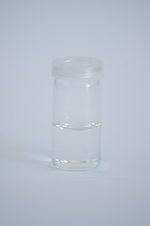|
Diethylene glycol dinitrate
Diethylene glycol dinitrate (DEGDN) is an explosive nitrated alcohol ester with the formula C4H8N2O7. While chemically similar to numerous other high explosives, pure diethylene glycol dinitrate is difficult to ignite or detonate. Ignition typically requires localized heating to the decomposition point unless the DEGDN is first atomized. Preparation and usesDiethylene glycol dinitrate can be made by nitration of diethylene glycol with nitric acid in presence of a dehydrating agent like concentrated sulfuric acid. DEGDN can be mixed with nitrocellulose or nitroglycol to form a colloid, which is used in smokeless powder for artillery and rocket propellant. During World War II, the Kriegsmarine frequently used this mixture in their artillery.[1] It has also found use as desensitizing plasticizer because it contributes to the power of the mixture while stabilizing the explosives. ToxicityIf ingested, like nitroglycerine, it rapidly causes vasodilation through the release of nitric oxide, a physiological signaling molecule that relaxes smooth muscle.[clarification needed] Consequently, diethylene glycol dinitrate has occasionally been used medically to relieve angina, which is substernal chest pain associated with impaired cardiac circulation.[citation needed] The rationale is that the concurrent headache it induces is somewhat less severe than other nitro compounds. UsesAt present, interest in the chemical seems to be mostly historical retaining only a few specialist uses. The medical application was never widespread, the standard nitroglycerine being faster acting and very inexpensive; oral nitrates in any case being only palliative, not an effective treatment. Triethylene glycol dinitrate, diethylene glycol dinitrate, and trimethylolethane trinitrate are being considered as replacements for nitroglycerin in propellants.[2] See alsoReferences
|
||||||||||||||||||||||||||||||||||||||||||||||||||||||||||||
